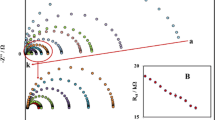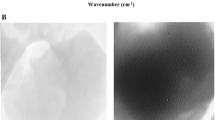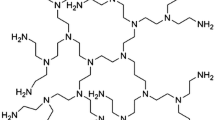Abstract
We report on the synthesis of conventional surfactant dodecylbenzenesulfonic acid-doped poly (o-anisidine)/graphene oxide composite (DPOMA/GO), a ortho-methoxy substituted derivative of anisidine, by in situ oxidative polymerization method. A mixture of Na2S2O8 in HCl was used as oxidant, while dodecylbenzenesulfonic acid was used as both dopant and surfactant. The physicochemical characterization was carried out using a field-emission scanning electron microscope and X-ray crystallography (XRD), Fourier transforms infrared, UV–Vis, and simultaneous thermo-gravimetric analysis study. Then, the DPOMA/GO nanocomposites were used to construct nonenzymatic sensors in practical with I–V technique, where the total analytical parameters were measured. The DPOMA/GO nanocomposites were deposited on flat silver electrode (AgE; surface area ~0.0216 cm2) to result in a sensor that has a fast response to selective benzaldehyde in buffer system. Features including sensitivity, detection limit, reproducibility, linear dynamic range, selectivity, and electrochemical performances were investigated in detail with the DPOMA/GO nanocomposites-fabricated AgE electrodes. The calibration plot is linear (r 2 0.9699) over the large concentration range (0.1 nM–0.1 mM). The sensitivity and detection limit are calculated as ~1.2277 µA cm−2 µM−2 and 0.03 nM (at a signal-to-noise ratio of 3), respectively.
Graphical abstract










Similar content being viewed by others
References
Acharyya SS, Ghosh S, Tiwari R, Sarkar B, Singha RK, Pendem C, Sasaki T, Bal R (2014) Preparation of the CuCr2O4 spinel nanoparticles catalyst for selective oxidation of toluene to benzaldehyde. Green Chem 16:2500
Novoselov K, Geim A, Morozov S, Jiang D, Zhang Y, Dubonos S, Grigorieva I, Firsov A (2004) Electric field effect in atomically thin carbon films. Science 306:666–669
Zhu Y, Murali S, Cai W, Li X, Suk JW, Potts JR, Ruoff RS (2010) Graphene and graphene oxide: synthesis, properties, and applications. Adv Mater 22:3906–3924
Compton OC, Nguyen ST (2010) Graphene oxide, highly reduced graphene oxide, and graphene: versatile building blocks for carbon-based materials. Small 6:711–723
Brodie BC (1860) Sur le Poids Atomique du Graphite. Ann Chim Phys 59:466–472
Staudenmaier L (1898) Verfahren zur Darstellung der Graphitsaure. Ber Deut Chem Ges 31:1481–1499
Hummers WS, Offeman RE (1958) Preparation of graphitic oxide. J Am Chem Soc 80:1339
Dreyer DR, Park S, Bielawski CW, Ruoff RS (2010) The chemistry of graphene oxide. Chem Soc Rev 39:228–240
Paredes JI, Villar-Rodil S, Martínez-Alonso A, Tascón JMD (2008) Graphene oxide dispersions in organic solvents. Langmuir 24:10560–10564
Szabo T, Szeri A, Dekany I (2005) Composite graphitic nanolayers prepared by self-assembly between finely dispersed graphite oxide and a cationic polymer. Carbon 43:87–94
Kim J, Cote LJ, Kim F, Yuan W, Shull KR, Huang JX (2010) Graphene oxide sheets at interfaces. J Am Chem Soc 132:8180–8186
Cote LJ, Kim J, Tung VC, Luo J, Kim F, Huang J (2011) Graphene oxide as surfactant sheets. Pure Appl Chem 83:95–110
Luo J, Laura JC, Vincent CT, Alvin TLT, Philip EG, Jinsong W (2010) Graphene oxide nanocolloids. J Am Chem Soc 132:17667–17669
Liu Z, Robinson JT, Sun X, Dai H (2008) PEGylated nanographene oxide for delivery of · water-insoluble cancer drugs. J Am Chem Soc 130:10876–10877
Potts JR, Dreyer DR, Bielawski CW, Ruoff RS (2011) Graphene-based polymer nano- composites. Polymer 52:5–25
Kuilla T, Bhadra S, Yao D, Kim NH, Bose S, Lee JH (2010) Recent advances in the graphene based polymer composites. Prog Polym Sci 35:1350–1375
Xia F, Mueller T, Golizadeh-Mojarad R, Freitag M, Lin Y, Tsang J (2009) Photocurrent Imaging and efficient photon detection in a graphene transistor. Nano Lett 9:1039–1044
Berger C, Song Z, Li X, Wu X, Brown N, Naud C (2006) Electronic confinement and coherence in patterned epitaxial graphene. Science 312:1191–1196
Stankovich S, Dikin DA, Dommett GH, Kohlhaas KM, Zimney EJ, Stach EA (2006) Graphene-based composite materials. Nature 442:282–286
Jiang X, Drzal LT (2010) Multifunctional high density polyethylene nanocomposites produced by incorporation of exfoliated graphite nanoplatelets 1: morphology and mechanical properties. Polym Compos 31:1091–1098
Pramoda KP, Hussain H, Koh HM, Tan HR, He CB (2010) Covalent bonded polymer–graphene nanocomposites. Polym Sci A Polym Chem 48:4262–4267
Fang M, Wang K, Lu H, Yang Y, Nutt S (2009) Covalent polymer functionalization of graphene nanosheets and mechanical properties of composites. J Mater Chem 19:7098–7105
Khan A, Asiri AM, Rub MA, Azum N, Khan AAP, Khan SB, Rahman MM, Khan I (2013) Synthesis, characterization of silver nanoparticle embedded polyaniline tungstophosphate-nanocomposite cation exchanger and its application for heavy metal selective membrane. Compos B Eng 45:1486–1492
Khan A, Asiri AM, Khan AAP, Rub MA, Azum N, Rahman MM, Al-Youbi AO, Qusti AH (2014) Dual nature, self oxidized poly(o-anisidine) functionalized multiwall carbon nanotubes composite: preparation, thermal and electrical studies. Compos B 58:451–456
Shi B, Zhong Y, Guo L, Li G (2015) Two dimethylphenyl imidazole dicarboxylatebased lanthanide metal–organic frameworks for luminescence sensing of benzaldehyde. Dalton Trans 44:4362
Koshy VJ, Prasad JV, Kalpana G, Satish S (1995) Investigations on intermediate acetal formation during polarographic estimation of certain benzaldehyde derivatives. Anal Chim Acta 307:55–60
Wang LH, Chen ZS (1996) Determination of free formaldehyde in nail preparations by differential pulse voltammetry. Electroanalysis 8:842–846
Sanz MB, Sarabia LA, Herrero A, Ortiz MC (2002) A study of robustness with multivariate calibration. Application to the polarographic determination of benzaldehyde. Talanta 56:1039–1048
Pramanik S, Zheng C, Zhang X, Emge TJ, Li J (2011) New microporous metal–organic framework demonstrating unique selectivity for detection of high explosives and aromatic compounds. J Am Chem Soc 133:4153–4155
Chen Z, Sun Y, Zhang L, Sun D, Liu F, Meng Q, Wang R, Sun D (2013) A tubular europium–organic framework exhibiting selective sensing of Fe3+ and Al3+ over mixed metal ions. Chem Commun 49:11557–11559
Balamurugan A, Kumar V, Jayakannan M (2014) Triple action polymer probe: carboxylic distilbene fluorescent polymer chemosensor for temperature, metal–ions and biomolecules. Chem Commun 50:842–845
Gole B, Bar AK, Mukherjee PS (2011) Fluorescent metal–organic framework for selective sensing of nitroaromatic explosives. Chem Commun 47:12137–12139
Wagh MS, Jain GH, Patil DR, Patil SA, Patil LA (2006) Modified zinc oxide thick film resistors as NH3 gas sensor. Sens Actuator B Chem 115:128–131
Yang Z, Huang Y, Chen G, Guo Z, Cheng S, Huang S (2009) Ethanol gas sensor based on Al-doped ZnO nanomaterial with many gas diffusing channels. Sens Actuator B Chem 140:549–556
Rahman MM, Khan SB, Asiri AM, Alamry KA, Khan AAP, Khan A, Rub MA, Azum N (2013) Acetone sensor based on solvothermally prepared ZnO doped with Co3O4 nanorods. Microchim Acta 180:675–685
Rahman MM, Jamal A, Khan SB, Faisal M (2011) Highly sensitive ethanol chemical sensor based on Ni-doped SnO2 nanostructure materials. Biosens Bioelectron 28:127–134
Xu JQ, Han JJ, Zhang Y, Sun YA, Xie B (2008) Studies on alcohol sensing mechanism of ZnO based gas sensors. Sens Actuator B Chem 132:334–339
Rahman MM, Khan SB, Gruner G, Al-Ghamdi MS, Daous MA, Asiri AM (2013) Chloride ion sensors based on low-dimensional α-MnO2–Co3O4 nanoparticles fabricated glassy carbon electrodes by simple I–V technique. Electrochim Acta 103:143–150
Rahman MM, Jamal A, Khan SB, Faisal M, Asiri AM (2012) Highly sensitive methanol chemical sensor based on undoped silver oxide nanoparticles prepared by a solution method. Microchim Acta 178:99–106
Sathish M, Mitani S, Tomai T, Honma I (2011) MnO2 assisted oxidative polymerization of aniline on graphene sheets: superior nanocomposite electrodes for electrochemical supercapacitors. J Mater Chem 21:16216–16222
Subrahmanyam KS, Vivekchand SRC, Govindaraj A, Rao CNR (2008) A study of graphenes prepared by different methods: characterization, properties and solubilisation. J Mater Chem 18:1517–1523
Bykkam S, Rao KV, Chakra CHS, Thunugunta T (2013) Synthesis and characterization of graphene oxide and its antimicrobial activity against klebsiella and staphylococcus. Int J Adv Biotechnol Res 4:142–146
Zhang L, Wang H, Yu W, Su Z, Chai L, Lia J, Shi Y (2012) Facile and large-scale synthesis of functional poly(m-phenylenediamine) nanoparticles by Cu2+-assisted method with superior ability for dye adsorption. J Mater Chem 22:18244
Longun J, Buschle B, Nguyen N, Lo M, Iroh J (2010) Comparison of poly oanisidine) and poly(o-anisidine-co-aniline) copolymer synthesized by chemical oxidative method. J Appl Poly Sci 118:3123–3130
Shi J, Wu Q, Li R, Zhu Y, Qin Y, Qiao C (2013) The pH-controlled morphology transition of polyaniline from nanofibers to nanospheres. Nanotechnology 24:175602
Xu S, Yong L, Wu P (2013) One-pot, green, rapid synthesis of flower-like gold nanoparticles/reduced graphene oxide composite with regenerated silk fibroin as efficient oxygen reduction electrocatalysts. ACS Appl Mater Interface 5:654–662
Chen H (2008) Mechanically strong, electrically conductive, and biocompatible graphene paper. Adv Mater 20:3557–3561
Song J (2014) Synthesis of Au/graphene oxide composites for selective and sensitive electrochemical detection of ascorbic acid. Sci Rep 4:7515
Ghosh S, Acharyya SS, Tripathi D, Bal R (2014) Preparation of silver–tungsten nanostructure materials for selective oxidation of toluene to benzaldehyde with hydrogen peroxide. J Mater Chem A 2:15726
Christophy E, Myli K, Viegut TR, Rzepiela JA, Hossenlopp JM (1997) Detection of benzaldehyde and formaldehyde in the UV photolysis of gas-phase methyl benzoate. J Photochem Photobiol A Chem 110:229–234
Fang C, Wang S, Wang Q, Liu J, Geng B (2010) Coralloid SnO2 with hierarchical structure and their application as recoverable gas sensors for the detection of benzaldehyde/acetone. Mater Chem Phys 122:30–34
Rahman MM, Khan SB, Asiri AM (2014) Fabrication of smart chemical sensors based on transition-doped-semiconductor nanostructure materials with µ-chips. PLoS ONE 9:e85036
Cheng XL, Zhao H, Huo LH, Gao S, Zhao JG (2004) ZnO nanoparticulate thin film: preparation, characterization and gas-sensing property. Sens Actuator B Chem 102:248–252
Srivastava JK, Pandey P, Mishra VN, Dwivedi R (2011) Structural and microstructural properties of PbO-doped SnO2 sensor for detection of methanol, propanol and acetone. Journal of natural gas chemistry. J Nat Gas Chem 20:179–183
Rahman MM, Khan SB, Asiri AM (2015) A microchip based fluoride sensor based on the use of CdO doped ferric oxide nanocubes. Microchim Acta 182:487–494
Rahman MM, Khan SB, Asiri AM (2013) Chemical sensor development based on polycrystalline gold electrode embedded low-dimensional Ag2O nanoparticles. Electrochim Acta 112:422–430
Rahman MM, Jamal A, Khan SB, Faisal M (2011) Fabrication of highly sensitive ethanol chemical sensor based on Sm-doped Co3O4 Nano-Kernel by solution method. J Phys Chem C 115:9503–9510
Rahman MM, Jamal A, Khan SB, Faisal M (2011) Cu-doped ZnO based nanostructured materials for sensitive chemical sensor applications. ACS Appl Mater Interface 3:1346–1351
Acknowledgments
Center of Excellence for Advanced Materials (CEAMR) and Chemistry Department, King Abdulaziz University, Jeddah, is highly acknowledged.
Author information
Authors and Affiliations
Corresponding author
Electronic supplementary material
Below is the link to the electronic supplementary material.
Rights and permissions
About this article
Cite this article
Khan, A.A.P., Khan, A., Rahman, M.M. et al. Conventional surfactant-doped poly (o-anisidine)/GO nanocomposites for benzaldehyde chemical sensor development. J Sol-Gel Sci Technol 77, 361–370 (2016). https://doi.org/10.1007/s10971-015-3862-6
Received:
Accepted:
Published:
Issue Date:
DOI: https://doi.org/10.1007/s10971-015-3862-6




